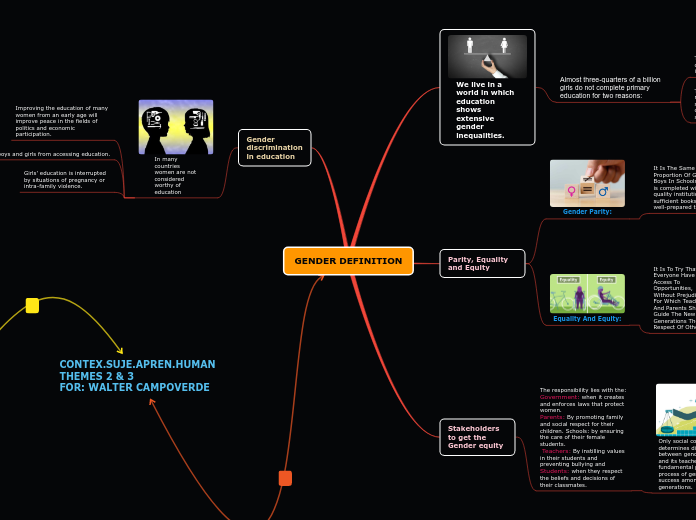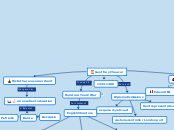CONTEX.SUJE.APREN.HUMAN THEMES 2 & 3 FOR: WALTER CAMPOVERDE
BIOLOGICAL DEVELOPMENT AND HEALTH
HOW HEALTH AFFECTS THE SCHOOL PERFORMANCE OF A CHILD AND ADOLESCENT
Genetics, environment, and social and family relationships are factors that influence whether you want to enjoy good health.
The relationship between school performance and various health concerns includes the following issues:
Chronic health problems. Diseases such as diabetes, epilepsy, cancer, hemophilia, congenital heart conditions, and HIV can affect children's school attendance and performance (UC San Diego Health, 2006).
Importance of breakfast. A healthy breakfast is an effective means of improving academic performance and cognitive functioning. Children with anemia can have academic disadvantages.
Exercise. Physical activity helps children develop social skills, improve mental health, and is associated with fewer risky behaviors. It affects the brain and improves students' cognition, mood, attention, and academic performance (UC San Diego Health, 2006).
Getting enough sleep provides benefits such as: improves memory, stimulates creativity, sharpens attention and reduces stress levels.
STAGES OF GROWTH AND DEVELOPMENT IN INFANTS AND CHILDREN
The Biology of adolescent development
In brain development, the adolescent frontal lobe responsible for judgment, drive, control, and planning is still maturing.
Sexual maturation or puberty begins at different ages depending on genetic and environmental factors.
The timing and speed with which these changes occur vary due to genetics and environment.
It is the transition period of the adolescent to being an adult, ranging from 10 to 20 years, where they reach height, weight and sexual maturity.
The biology of child development and learning
Genes and environmental factors and experiences influence the child development. Neither environment nor biology alone is destiny.
The brain develops through a dynamic interaction between underlying biological processes and exposures and experiences in the environment.
During this process, children generally learn to crawl, sit without support, babble, and copy sounds. This event is strongly influenced by genes passed down from parent to child. covers the following skills:
Sensory awareness – the registration of sensory information for use(Kid sense)
Physical skills – fine motor (finger) skills and gross motor (whole body) skills
Speech and Language – understanding and using language, reading and communicating
Social interaction and emotional regulation – interacting with others and mastering self-control
Cognition – the ability to learn and problem solve
Children go through different periods in their growth since they are in the uterus, they present different prenatal stages.
Brain development before birth
Its development begins from the third week of gestation and extends until the end of adolescence. Molecular events and the impact of the environment greatly influence its development. Both are essential and any interruption can fundamentally alter neural outcomes.
The pre-natal stages of development
Remarkable Changes Are Presented That Will Help Postcological Development In The Future, Where The Brain Develops In Three Main Stages: Germinal, Embionic And Fetal.
GENDER DEFINITION
Gender discrimination in education
In many countries women are not considered worthy of education
Girls' education is interrupted by situations of pregnancy or intra-family violence.
Poverty prevents boys and girls from accessing education.
Improving the education of many women from an early age will improve peace in the fields of politics and economic participation.
Stakeholders to get the Gender equity
The responsibility lies with the: Government: when it creates and enforces laws that protect women.
Parents: By promoting family and social respect for their children. Schools: by ensuring the care of their female students.
Teachers: By instilling values in their students and preventing bullying and Students: when they respect the beliefs and decisions of their classmates.
Only social construction is what determines discrimination between genders, the school and its teachers are the fundamental part for the process of gender equity to be a success among future generations.
Parity, Equality and Equity
Equality And Equity:
It Is To Try That Everyone Have Free Access To Opportunities, Without Prejudice, For Which Teachers And Parents Should Guide The New Generations The Respect Of Others.
Educational equity It ensures that students from low or indigenous, Afro-Ecuadorian backgrounds have access to well-prepared teachers and up-to-date materials in technology.
Educational equality: Ensures that all students have the same number of resources.
Gender Parity:
It Is The Same Proportion Of Girls And Boys In Schools. Which is completed with quality institutions, sufficient books and well-prepared teachers.
We live in a world in which education shows extensive gender inequalities.
Almost three-quarters of a billion girls do not complete primary education for two reasons:
The girls do not have the same opportunities as boys
The quality of the school is poor









